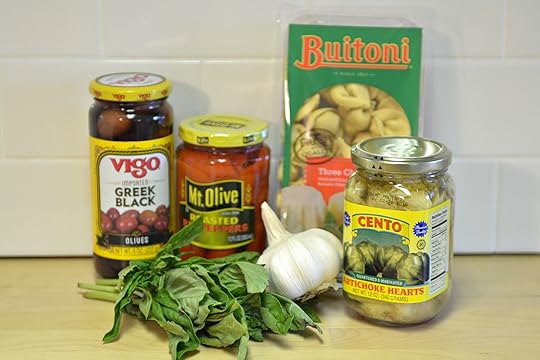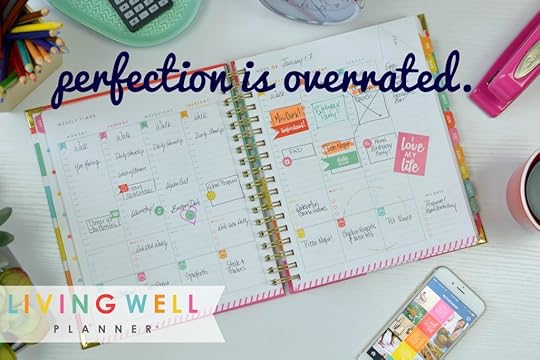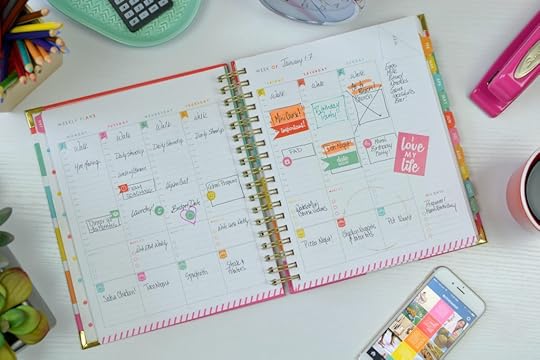Ruth Soukup's Blog, page 59
July 15, 2016
The Living Well Planner is Back (& Better Than Ever!)
Friends, none of us start out hoping for ordinary.
We donât begin our lives hoping for average. For a marriage that is just okay. For a career that we tolerate, but donât really love. For friendships that are superficial. For hobbies and pastimes that donât really excite us. For most of the time, just trying to make it through the day.
When we are young, we believe we can do anything, that anything and everything is possible. And every day is a new adventure.
Wouldnât it be nice to feel that way again?
Like anything is possible?
Wouldnât it be nice to jump out of bed in the morning, simply because you canât WAIT to start your day? Wouldnât it be nice to begin your day with purpose and clarity instead of simply going through the motions?
What if you really could have it all?
What if you could be the wife and the mom you want to be, the one you know you are inside. The one who radiates a joy that permeates her entire family? What if you could do the work youâve always wanted to do, the work that fills you up and makes you feel whole, the work that sparks your passion and allows you to live in your sweet spot?
What if you were finally able to manage and keep track of all those details that so often get you off track and make you feel like you are failing? What if getting dinner on the table was effortless, a natural extension of your day, or you were finally able to get a handle on your finances and begin making your money work for you instead of the other way around?
What if you dared to give yourself permission to go after your goals and dreams? To stop putting them off for fear of failure and instead had the courage to do it scared?
What if?
This is what the Living Well Planner is all about. Itâs the practical tool that can help you harness the power of WHAT IF.
It is your daily reminder that anything is possible.
When it debuted last year, I knew the Living Well Planner had the potential to be life changing. It was the first of its kindâan all-in-one tool not just for planning your days, but for keeping track of your budget, managing your home, planning your meals, and reaching your goals.
And you loved it.
Over the past year, the feedback we have received from planner users has been incredible.  This amazing tool really has changed lives.  But we also knew we could do even better. And so the refining process began again.
We left no stone unturned in our quest to create the most useful planning tool imaginable, taking every single comment and suggestion to heart in order to improve upon the original and create a planner that will rock your world (but only in the best possible way!)
Here are just a few of the improvements that weâve made this year:
SMALLER SIZE: We’ve shrunk the page size just slightly, from 8.5×11 to 7.5×9.5–still big enough to give you enough room to write, but easier to tote along
THICKER PAPER: We took it from 50# weight to 60# for increased durability.
FRONT POCKET: Because sometimes you just need a place to put stuff!
REIMAGINED COVER: A simple, bright & cheery stripe pattern with a durable eggshell finish, along with reinforced metal corners will help keep your planner safe all year long.
HOUR-BY-HOUR SCHEDULING: Weekly planning & time-blocking made easier with a vertical layout and room for hour-by-hour appointment scheduling.
SIMPLIFIED MEAL PLANNING: One block for all meals, giving you the option to plan just one meal a day, or all three.
BETTER BUDGETING: Weâve made our budgeting pages even more intuitive and user-friendly.
GOAL CRUSHING: This might just be the one single improvement we’re MOST excited about. You see, goal setting is all well and good, but we don’t want to see you just set your goals, we want to see you CRUSH your goals! Our exclusive Goal Crushing⢠system will transform the way you get things doneâwe promise!
Like before, the Living Well Planner is printed in full color, and is fully printed and manufactured right here in the USA.
It is still undated so that you can begin using it at any time, and it offers space for planning out the year, as well as monthly goal-setting and monthly budget pages. It also includes labels for customizing your planner, including wrap-around monthly tab stickers that actually help reinforce the tabs while allowing you to easily find the month you are looking for.
More importantly, the Living Well Planner offers a tangible solution to the chaos of a busy life, and it will empower, enable, and inspire you to take back your time and manage your schedule, allowing you to focus on your BIG goals while still navigating the daily, weekly, and monthly responsibilities of running your home.
It is designed to help you find the balance you crave, to allow you to be the best version of yourselfâthe mom and wife and friend and person you want to beâwhile giving you permission to make your dreams a reality.
In other words?
It is the sanity saver weâve ALL been waiting for!
The all-new Living Well Planner will begin shipping on August 31st, but when you pre-order now, you can take advantage of our Early Bird pricing and get it for just $49. (Once it begins shipping, the regular price will be set at $55.)
Last year we sold out before our first planner even began shipping, so we highly recommend ordering as early as possible, as all planner orders will be shipped in the order they are received!
It IS possible to crush your goals and create a life you love, even in the midst of a never-ending stream of responsibilities.
Preorder the Living Well Planner today, and start as soon as August 31st.
');
Buy Living Well Plannerâ¢Pin It
The post The Living Well Planner is Back (& Better Than Ever!) appeared first on Living Well Spending Less®.
July 13, 2016
Lemon Zucchini Pancakes

This is a guest post from Sammi of Grounded & Surrounded
Zucchini is such a fun vegetable. I love it in sweet treats and savory entrees; from muffins to quiches, cookies to meatballs, the options are endless.
Not only does my family love pancakes, but we love trying new flavors of pancakes. This recipe was created when our garden was producing a bountiful crop of zucchini. I was adding it to everything- muffins and bread, stir frys, salad dressings (yes, it can be done!), and ultimately these Lemon Zucchini Pancakes.
What is it about pancakes that bring a family together? Have you ever offered to make pancakes and had complaints? Of course not! Pancakes are one food that is universally loved.
And another selling point, as if these pancakes need it, is your family will be getting a serving of vegetables while happily eating pancakes. That is most definitely a mom win in my book.
You may be wondering why I chose to add lemon to these pancakes. My answer is, why not? The citrusy aroma of the lemon in this delicate pancake is intoxicating. You will wish you kitchen could always smell this good.
Lastly, I must warn you, this pancake recipe feeds a small army. I love making the full recipe and freezing half for mornings when I don’t have as much time to dedicate to breakfast prep. If you are making this recipe for 1 or 2 people and have no interest in freezing them for later, you may want to cut it in half.
My children have been gobbling these little flapjacks up like crazy lately and I hope your family will enjoy them as much as we have. Don’t be afraid to experiment in the kitchen, you might be surprised by what you are able to create.

Here is what you need:
3 cups flour
¼ cup sugar
3 Tbsp baking powder
1 tsp baking soda
3 eggs
¼ cup melted butter
2 cups milk
¼ cup lemon juice
Zest of 2 lemons or about 2 Tbsp
2 tsp vanilla extract
2 cups finely shredded zucchini zucchini water

Step 1: Mix all dry ingredients in a large bowl. Set aside.

Step 2: To a medium sized bowl, add eggs, melted butter, milk, and vanilla. Next, zest your washed lemons over a plate and add the zest to your wet ingredients. Place your zested lemons aside for now. Over that same plate, shred your zucchini finely with a grater. Do not wring out the excess water from the zucchini shreds, add it all to your wet ingredients. Finally, squeeze the lemons you zested over a small bowl and strain out any seeds. Add this last ingredient to the medium-sized bowl and whisk all wet ingredients together!

Step 3: Add wet ingredients to dry ingredients and gently fold together until combined. The batter will be light and fluffy with some lumps. Remember, too much mixing makes pancakes gummy and dense.

Step 4: Heat pan over medium heat and spray with nonstick cooking spray. Make sure your pan is hot before you add your batter, otherwise the pancakes will spread too much and not be fluffy. Turn down heat to low. Cook the pancakes low and slow. Once the pancakes have bubbles and the edges are cooked, flip pancake and cook until they are a nice golden brown.

Recipe Notes:
Zucchini pancakes tend to be a little wet within the middle, but cooking low and slow and over-cooking rather than under-cooking seem to be the trick to the perfect Lemon Zucchini Pancake.
To freeze pancakes, place them in a single layer on a baking sheet lined with parchment paper and put in freezer until frozen. Remove from baking sheet and store the frozen pancakes in a gallon-sized Ziploc bag. To reheat, place frozen pancakes in toaster oven much like a piece of toast!
Print This!
Recipe: Lemon Zucchini Pancakes
Summary: Zucchini and lemon were meant to be together. These light pancakes will awaken your tastebuds and are the perfect addition to your breakfast or “brinner” menu.
Ingredients
3 cups flour
¼ cup sugar
3 Tbsp baking powder
1 tsp baking soda
3 eggs
¼ cup melted butter
2 cups milk
¼ cup lemon juice
Zest of 2 lemons or about 2 Tbsp
2 tsp vanilla extract
2 cups finely shredded zucchini zucchini water
Instructions
Mix all dry ingredients in a large bowl. Set aside.
To a medium sized bowl, add eggs, melted butter, milk, and vanilla. Next, zest your washed lemons over a plate and add the zest to your wet ingredients. Place your zested lemons aside for now. Over that same plate, shred your zucchini finely with a grater. Do not wring out the excess water from the zucchini shreds, add it all to your wet ingredients. Finally, squeeze the lemons you zested over a small bowl and strain out any seeds. Add this last ingredient to the medium-sized bowl and whisk all wet ingredients together!
Add wet ingredients to dry ingredients and gently fold together until combined. The batter will be light and fluffy with some lumps. Remember, too much mixing makes pancakes gummy and dense.
Heat pan over medium heat and spray with nonstick cooking spray. Make sure your pan is hot before you add your batter, otherwise the pancakes will spread too much and not be fluffy. Turn down heat to low. Cook the pancakes low and slow. Once the pancakes have bubbles and the edges are cooked, flip pancake and cook until they are a nice golden brown.
Recipe Notes:
Zucchini pancakes tend to be a little wet within the middle, but cooking low and slow and over-cooking rather than under-cooking seem to be the trick to the perfect Lemon Zucchini Pancake. I use a 1/4 cup measuring cup to scoop the batter and pour onto the hot pan.
To freeze pancakes, place them in a single layer on a baking sheet lined with parchment paper and put in freezer until frozen. Remove from baking sheet and store the frozen pancakes in a gallon-sized Ziploc bag. To reheat, place frozen pancakes in toaster oven much like a piece of toast!
Preparation time: 5-7 minutes
Cooking time: 20-22 minute(s)
Number of servings (yield): 26 4″ pancakes
Sammi Ricke likes to keep things simple, delicious, and nutritious in her kitchen.
She enjoys the challenge of finding unique ways to incorporate “just one more whole food” into every meal while leaving just enough room for life’s essentials: chocolate and peanut butter. If you are looking for “healthified” versions of your family’s favorite meals be sure to visit Sammi’s Grounded & Surrounded Blog. You can also find her on Pinterest, Instagram, and Facebook.
* * *

Pin It
The post Lemon Zucchini Pancakes appeared first on Living Well Spending Less®.
July 11, 2016
8 Ways to Maintain Your Work/Life Balance

Raise your hand if you’ve ever felt a little overwhelmed by the pressures of trying to juggle a career or a business with keeping up on all your responsibilities at home.
For many of us, life can feel pretty darn full most of the time. Our schedule is packed to the gills, filled with obligations, responsibilities, appointments, and meetings. We’re so busy that even the good stuff–the things we want to do–start to feel like a chore.
We’re all familiar with the dangers of too much physical stuff. Too much stuff and not enough room can lead to piles, clutter and disorganization. Eventually, we feel like we’re in a cave, surrounded by the things we own, with no way to dig ourselves out.
But there is another kind of clutter that can take over our lives and be almost more dangerous and damaging than a house full of items. And that is the weight of an overbooked life.
It’s what happens when we just can’t say no, for the fear of missing out. Or even if we can say no, it’s when we’ve still got so many obligations it’s hard to find balance and footing. And for many working moms (and even stay-at-home moms too), it’s a real problem. Between parenting, work, household chores, obligations at church, social and civic duties, most of us have virtually zero time for ourselves. Plus, we’re constantly worried we’re not doing enough, that somehow we are always shortchanging our kids, spouse, and those we hold dear.
But the reality is that life is not always perfectly balanced. Sometimes we will necessarily have to neglect some of our duties at home in order to handle a big project at work. Sometimes we might need to be okay with dinner through the drive through because we’ve got to drive to ballet and piano and baseball after school, and there’s no time to cook. Sometimes work will have to get put on the back burner because our child is sick. The pendulum tends to swing back and forth.
And while there isn’t such a thing as perfect balance, there is a way to find a better work/life balance, even in the midst of a very busy life, especially when you feel like the pendulum has shifted too far to one side. The following eight strategies can help:

1. Guard Your “Yes” Carefully
I’m not going to tell you to say “no” to everything. It’s not feasible, nor realistic. We don’t live in a bubble, and the reality is that many of us derive great pleasure from doing things for others. When it comes to social time, church activities, parenting groups and other obligations, they can be fun, enrich our lives and make us happy.
But you do have to say no sometimes, and probably more than you are right now.
Rather than a negative thing, think of it as guarding and valuing your yeses. You only have a finite amount of hours in the day and a set number of things you can do in a given amount of time. When you commit to doing something, ask yourself three questions:
Will this bring me (or someone else joy)?
The same questions you ask when you’re deciding what to keep when cleaning out your closet can apply when you’re cleaning out your schedule. Not every single job we do is joyful, but ultimately, everything can lead to improvements and positive results in our life.
Going to work might not bring you joy at the moment, but it may help you provide for your family, make a difference in the lives of others, or give you pride in a job well done—and that can lead to joy and satisfaction. Life is too short to do things that make you miserable. We all have obligations, but it’s how you frame them and view them that can help weed out the necessary from the unnecessary.
Is this a productive or memorable use of my time?
I add “memorable” to this question because not everything we do has to be productive. We’re not minions or mindless cogs, aiming only for the highest levels of productivity.
Going on vacation, a picnic, or a bike ride with your family can be productive, too. It builds memories, bonds you with your family and makes you happy. Zoning out in front of the television on the other hand is probably neither productive nor memorable. If a good book or your favorite show engages you, enriches your life, or is worth your time, then go for it, but if you’re simply spacing out, then fill your time jar with something else.
Am I learning, growing or getting better?
Stretching ourselves a little further each time we do something can lead to constant growth. Just like we have to push our muscles to build them up and make them stronger, we have to keep stretching and doing heavy lifting with our brain as well. If we’re always trying to grow and better ourselves in each activity, we won’t get bored, nor will work (or any activity) feel like drudgery.
The secret to keeping things interesting is to keep them challenging and fresh. Take on a new project at work, learn a new hobby, or switch up your running route a little. It might seem counterintuitive to take on tasks that seem more challenging or out-of-routine, but when something’s easy, it doesn’t make it pleasurable or interesting. We like to be challenged.

2. Let Go of Guilt and Perfection
This one is hard for me, and I think it’s hard for most women, especially moms. We’re all trying to do things well. There’s a lot of blogs and Facebook posts, groups and Pinterest boards telling us what constitutes being a “great mom,” a “perfect wife,” and other mythical figures.
Not one of us is perfect. Give yourself a little forgiveness and grace. Take the pressure off. You don’t have to be a perfect housekeeper, maintain a garden, run a home-canning operation, and sew your children’s clothing to have a great life.
Remember, the things people post on social media and blogs—and even what they share at PTO meetings—are a lot of “best of” moments. No one shows their myriad of trial and errors, like mentioning the three times they had to rip a seam out of pajama pants they were trying to make, or the batch of cookies burnt to a crisp. Most of us only show off our successes. When you’re viewing someone’s photos or reading about their lives, you’re getting their greatest hits.
As much as I try to be real and talk about learning experiences and challenges here on LWSL, I can tell you that even I am occasionally guilty of only putting my better foot forward. Don’t compare yourself to others. We’re all fighting a hard battle.
3. Manage Your Time Wisely
My Living Well Planner keeps me sane. I live by it. I have to schedule things, including my leisure time, workouts and date nights. It sounds silly, but when you’re busy, putting things on the schedule can help you let go and really enjoy nourishing activities.
If I don’t put my free time on the calendar, I have this nagging feeling I’m “stealing” my time—I’m procrastinating, I’m avoiding, or I’m not managing my time as wisely as I could. In fact, it makes it harder to really engage and focus on what I’m doing instead; whereas, if I have something on the calendar like, “playtime with the girls,” then I can fully immerse myself in the experience and enjoy it. I know there’s time put aside for work and it will still be there, organized on my calendar when I get to it.
Granted, I designed it to do just that (for the exact purpose of trying to create more balance in my life) but I especially love that my Living Well Planner allows me to keep all the pieces of my busy life organized in one place. I can create goals for all the different areas of my life, and see them at a glance. I can easily keep track of my budget, expenses, prayer requests, meal plan, and to-do list, and never feel like something is slipping through the cracks.

4. Tackle the Hard Things
One of my very favorite books of all time is called Eat That Frog: 21 Great Ways to Stop Procrastinating and Get Things Done by Brian Tracy. It got its name from a quote by Mark Twain, who famously once said something to the effect of “if you eat a frog for breakfast, chances are that will be the worst thing you have to do all day.” The point of the quote—and the book—was that if you start your day by tackling your hardest but most important tasks, even if you don’t do that much for the rest of the day, you will still have accomplished a lot.
Eating the frog is one of the secrets to great time management. When you get into work, pick the task you’re dreading the most. Do it first and get it over with. If you put it off, you’ll find you’re spinning your wheels and using timewasters to avoid doing the “frog” task you don’t want to do. Just suck it up and get it done. Once the big, bad tough task is off your schedule, you’ll be amazed at how much more productive you feel.
Often our schedules fill up with distractions. We find things to do INSTEAD of the big scary things we’d rather not face. Face the monster, slay the dragon, and your day will go much smoother.

5. Take Help When You Can
I am incredibly lucky to have a supportive husband by my side who helps me with parenting, meal making, and tackling household tasks. I know, not everyone has such a supportive partner and I deeply appreciate all he does. That said, I still find, even as willing as he is to help, sometimes I’m reluctant to ask.
We all want to DO IT ALL. Unfortunately, none of us is Superwoman. We all need a helping hand. That means when someone offers to assist you, learn to let them experience the joy of service and the blessings that come from helping others. It can be hard to let go of our pride and ask for assistance, but reframe it as giving someone the opportunity to do a good deed.
Think how great you feel when you can help your spouse or when a friend needs something and you’re there. We all love to feel useful and helpful. We love that glow and joy of assisting those who need someone. Let someone else experience those same blessings by helping you when you have a time of need.

6. Trade with a Friend
Free up your time and find more balance by trading household tasks with friends. Try a meal swap with a few moms and dads in the neighborhood, where each family takes a night and prepares a meal. Often, it’s much simpler to make seven of one casserole or pasta dish than it is to create seven different dishes each week. Each person takes one night and then you simply swap it up.
Consider doing the same when it comes to playgroups and babysitting, repairs, dog walking, yardwork and more. It’s always more fun to do things in a group, and sometimes it’s simpler to a task en masse then it is to do it for one. Carpool, and trade pick-up trips to school or rideshare to the office. You’ll save on cost, car repairs and time.

7. Stop Doing What You Hate
It sounds like a no-brainer, but if there’s something on your schedule you do out of obligation, guilt or stress, STOP. Say no!
I know it’s not that simple. If you have bills (and who doesn’t), kids, a spouse and a mortgage, you can’t just decide, “Gee, I don’t like work, so I’m going to quit.”
That said, you can identify the things in your life making you unhappy. I’m talking about listing the things you dread doing: those soul-sucking, draining activities you’d prefer just to avoid. Then, figure out ways to make that change. It might not happen instantly. You might not be able to leave a job overnight or wave a magic wand and have a different social circle, but identify the things you really want to change. Write them down and then write down the steps you need to take to make changes.
This might mean figuring out ways to get out of debt. It might mean paring down and organizing your home, selling items, and eventually consolidating to a smaller house. It might mean finding a way to go back to school.
When I started to take on home school for my girls, it seemed like it would be an amazing experience. I had visions of how it would work out perfectly and we would have days filled with enriching, educational activities, bonding and discovery. After trying it for quite a while, my husband and I made the decision it was NOT working for our family, so instead, we found a values-based private school that would give our daughters more social experience and greater structure, and yes, would also allow my schedule to be more open to growing my business.
It wasn’t an easy experience and it was definitely a humbling lesson, but it was one I value greatly. I realized I couldn’t do it all. Maybe I was wrong about what I could take on. I realized I needed to change our course, not only for my wellbeing, but for the wellbeing of my family.
Examine the things that aren’t bringing you joy and find a plan and take steps to get to a better place. It won’t happen overnight, but it will happen. The results may be even better than you imagine.

8. Stay Positive & Help Others
Saying, “I’m so stressed out” becomes a self-fulfilling prophecy. Rather than focusing on how thin you’re stretched and how daunting things seem, focus on what you can control now. Take things one day at a time and practice gratitude every single day.
No matter how rough the waters get, we always have at least a few things we can be thankful for. Every experience fortifies our character and shapes us into who we are. Without stress, we wouldn’t be as strong.
Every day, identify the positive things in your life. Affirm the things you’re grateful for and seek ways you can help those around you. If you feel things are rough and nothing is going your way, pray for grace and understanding. Even at our darkest moments, there’s still a path before us. Sometimes we can’t see it, and those are the times we just have to keep putting one foot in front of the other.
In the words of Fred Rogers, “Real strength has to do with helping others.” When you need a boost, do something for someone else.
* * *
Creating and maintaining a healthy work/life balance can seem like an impossible feat sometimes, but in the end it comes down to recognizing that the pendulum will always be swinging. Your job is to give yourself grace, do the best you can, and make sure it doesn’t get stuck on one side.

Pin It
The post 8 Ways to Maintain Your Work/Life Balance appeared first on Living Well Spending Less®.
July 8, 2016
How to Raise Confident Kids

Let’s face it–parenting can be a pretty tough job sometimes. It’s so much more than just getting dinner on the table, changing diapers, helping out with homework, and providing a place to sleep. In fact, that’s the easy part. The tough part is making sure our kids grow up learning everything they need to know to not just survive in life, but to thrive.
The older I get, the more I see that SO many hurdles for women in life come from a lack of self-worth, low confidence, and a shaky sense of identity. The same can also be said for boys, although it may manifest itself in different ways. For both genders, low confidence means going along with the crowd, rebelling, and making decisions based on what others want, rather than setting their sights on positive accomplishments and goals.
And that is why it is so important to raise confident kids, even from an young age.
Granted, it is no easy feat, but here are a few things I’ve learned so far.

1. Praise Accomplishments, Not Abilities
Rather than always saying, “You’re so smart,” or, “You’re so pretty,” instead, try praising the accomplishment. For example, “I’m so proud of you for studying so hard and sticking it out so you could get 100% on your spelling test!”
When we praise abilities, it sends the message that our children are born with certain traits (pretty, smart, athletic, etc.) and we only like them because of these particular inherit traits. Most things, however, can be accomplished with determination, hard work and practice. Praising the accomplishment (and acknowledging the work it took to get there) sends the message that it was their perseverance and practice that got them to their goal. Confidence comes from setting and achieving goals.
2. Allow for Learning Experiences
This can be a tough one. (I know it is for me!) It can be hard to suppress the urge to swoop in and correct, fix or otherwise advise your child on a project or task. It’s TOTALLY OKAY if everything isn’t perfect. It’s okay if your kid falls down once in a while as they’re learning to ride a bike. It’s okay if they don’t get a perfect score on every project or test. It’s okay to cringe when they do something a little irresponsible.
Help your child come up with a vision and plan for their project and then let them carry it out. Of course, it might not be how you would do it, but allowing your kids to experience bumps in the road and problem-solve teaches them grit. It gives them the ability to cope with life’s uncertainties and it helps them feel confident and proud when they come up with solutions on their own.

3. Don’t Be Afraid to Let Your Child Hurt
For a mother, nothing is more heartbreaking than to see your child hurt, physically or emotionally. In fact, the emotional stuff can sometimes be even more gut-wrenching. If your child is disappointed, sad, or if they feel bad about something, allow them to feel it. Don’t jump in and try to fix everything.
This is really tough. Mothers are natural rescuers and “fixers.” We want to help, always. Instead, let your child experience disappointment and allow them to work through their emotions. This will help them to learn it’s okay to be emotional and it’s okay to feel disappointment. Give you child the chance to come up with a solution to avoid experiencing similar issues down the road.
4. Encourage Perseverance
When something doesn’t go well, it’s easy to throw in the towel. A few months ago, I saw a video on Facebook of a gymnast repeatedly falling down. She went through attempt after attempt to nail her landing. The lesson from the video was: we always see the final victory, but in reality, most of the time, it took years of practice and failed attempts.
Just like many adults, kids look at those around them and think everyone else is able to do things easily. Encourage your children to practice and keep trying. Don’t give up on a first attempt just because it’s hard or challenging. If at first you don’t succeed, try, try again.

5. Don’t Refine or Redo Your Kid’s Work
When your child messes up a chore or task, resist the urge to go behind them and redo it. So they leave streaks on the bathroom mirror or miss a spot when they’re cleaning the counter. Instead of redoing tasks to be up-to-standard, praise your child for their efforts and let it go.
I know, it’s not easy to let your child walk out of the house with a wonky hairstyle or mismatched clothes, but you know what? No one notices or is judging you, and even more importantly, kids learn independence and the ability to complete tasks on their own.
6. Set Them Up for Success
Doing any job is easier when our kids have the right tools and directions. It’s also important they keep their goals realistic and “baby step” toward the ultimate or larger goal. Help your child learn to prepare with the right tools for the job and clear instructions. Don’t leave room for temptations and distractions.
If your child struggles with concentration or focus, provide them with a quiet spot and ample time on the schedule to complete their task. If your child is easily frustrated, help them break down a task into smaller pieces. If you have a kid who isn’t athletic, give them an opportunity to work up to the big game, practice with them, and ensure they have the equipment they need to be successful.

7. Don’t Set the Bar Too High
If you walked out your front door today, chances are good that you couldn’t complete a marathon (unless you’re a regular runner). Your child is the same way. Kids don’t operate on the same ability and logic level as adults. I find I’m just as guilty as anyone of becoming frustrated when my kids can’t figure something out or use logic to solve a problem.
Of course I want my kids to get straight A’s and be great at everything they do. Sometimes though, you have to realize that they’re young and simply learning. Doing hard things means you won’t be great at everything right off the bat. You have to break things down into smaller, teachable moments and goals. Give your kids the chance to feel small successes and victories along the way. This gives allows them to feel a true sense of accomplishment when their task is successfully completed, even if they don’t bite off the whole project at once. You might feel like you’re starting small, but that’s part of the learning process. It’s okay if they miss a few answers on the test or if they don’t get a perfect score.
8. Learn from Mistakes
Each mistake is a learning opportunity. It’s easy to look at a mistake or misstep as a failure, but it’s much better to look at it as a chance to learn something new and grow. Our kids need grace, and they also need to know it is okay to make mistakes sometimes, that everyone makes mistakes, and that the most important thing we can do is learn from them and move on.
It’s hard to treat mistakes as opportunities to learn and grow. It’s much easier to blow up, get frustrated and throw a fit. Kids and parents both can struggle with this. Admitting you might be wrong is a very humbling experience—and you won’t believe what you might learn by doing it.

9. Model Positive Self-Confidence
If you want confident kids, you have to be a confident adult. How often do your kids hear you say, “Ugh, I’m so bad at this,” or, “I look so fat in these pants,” or “I’m such an idiot”?
Ban negative statements from your vocabulary. Kids model behavior whether or not we realize what they’re doing. They might not directly repeat your self-doubt and criticism, but they’ll learn it’s “normal” to tear themselves down. If, instead, you step back and say, “Well, I’m going to have to keep trying,” or, “I’d better get in some more practice,” your child will learn to follow your example of picking yourself up by the bootstraps and getting back on the horse. Kids learn by example. Be sure you’re setting the best one possible.
10. Teach Rather than Critique
One of our biggest parenting challenges is how to teach rather than simply critique. Teaching means coaching and encouraging. It means asking questions and giving kids a chance to use logic to solve a problem, plan, schedule and carry out a goal. To critique simply means to review the final outcome.
No parent is perfect, and I know I’m far from it, but raising confident kids means helping him or her discover, learn and grow from each experience. Whether you’re a homeschool teacher, a stay-at-home mom or dad, or a full-time working parent, you’re still a teacher. All parents are. Use this gift to help your kids grow and develop into their fullest potential.
Confidence isn’t something we’re naturally born with. It’s something we grow into. It’s a lifelong challenge and almost all humans struggle with it at some point. Often, those who come off as confident or arrogant are actually insecure. Quiet confidence is subtle. It means you have faith in your own abilities and a strong sense of self-identity.
When you stumble on the path as a parent, remember to have faith and don’t be afraid to request guidance and help. Parenting can be challenging, but hold fast to your confidence—you can rise to the occasion!

The post How to Raise Confident Kids appeared first on Living Well Spending Less®.
July 6, 2016
Coffee & Cookie Ice Cream

Everybody needs a super simple go-to dessert and I’m pretty sure I just found mine! This oh-so-easy, Tiramisu-inspired Coffee & Cookie Ice Cream dessert comes together so fast it can hardly even be called a recipe, and yet the the flavors make it an impressive showstopper. Because the only thing better than a delicious dessert that only takes minutes to throw together is one that tastes like you slaved all day.
For this version I used vanilla ice-cream, hazelnut flavored coffee and 1 package Stella D’oro Anisette Toast Cookies. I’m sure you could substitute your own favorite flavors with just as much success.

Here is what you need:
1 Tablespoon sugar
1 cup flavored coffee
1 package Stella D’oro Anisette Toast Cookies
1 half gallon vanilla ice cream
Chocolate shavings for garnish (optional)

Step 1: Dissolve the sugar in the coffee and then chill.

Step 2: Dip the cookies into the coffee, one at a time and arrange them into the bottom of the glass pan.

Step 3: Scoop the ice cream into a bowl and mix until softened.

Step 4: Spread over cookies to form a smooth surface. Cover with plastic wrap. Freeze until firm, about 2-3 hours or overnight.

Step 5: Let soften slightly before scooping into bowls add chocolate shavings and serve.

Print This!
Recipe: Coffee & Cookie Ice Cream
Summary: This super simple dessert is cool, refreshing and oh so yummy!
Ingredients
1 Tablespoon sugar
1 cup flavored coffee
1 package Stella D’oro Anisette Toast Cookies
1 half gallon vanilla ice cream
Chocolate shavings for garish (optional)
Instructions
Dissolve the sugar in the coffee and then chill.
Dip the cookies into the coffee, one at a time and arrange them into the bottom of the glass pan.
Scoop the ice cream into a bowl and mix until softened.
Spread over cookies to form a smooth surface. Cover with plastic wrap. Freeze until firm, about 2-3 hours or overnight.
Let soften slightly before scooping into bowls, add chocolate shavings and serve.
Preparation time: 5-7 minutes
Cooling time: 2-3 hours
Number of servings (yield): 8-10

Pin It
The post Coffee & Cookie Ice Cream appeared first on Living Well Spending Less®.
July 1, 2016
How to Love the Life You Have

This is a guest post from Author Alexandra Kuykendall
I’d had it. Done. I was stretched thinner than I could handle. My life was no longer sustainable, much less fun. I was running (sometimes literally) from one soccer practice to the next. Transporting my four children to schools and dentist appointments was a full-time job on its own. Not to mention working an actual part-time job and trying to get dinner on the table on a semi-consistent basis.
Loving my actual life?! I was hardly able to survive it.
And so I needed to make a change. But I wasn’t sure what or how. Where does one begin when she wants to love the life they she is already living? I figured an experiment was in order, one that would allow me to try different approaches. I knew the changes had to be small and immediate. If I couldn’t make the change within twenty-four hours, it was probably too difficult to implement, much less maintain long-term.
I also decided a systematic approach was in order because if I tried to do everything all at once, nothing would actually get accomplished. I knew it was smart to focus on one area of my life at a time, but how to choose? I considered what I missed, longed for even, in my days. And I did an honest evaluation of what I’d been putting off in my regular routines. This frank examination of my current state of crazy pointed to nine areas. So a nine-month experiment was born where I focused on each component for a month to find what would help me better love my life today.
We all must do our own self-examination to determine where we should place our focus, but in my conversations with other moms, I’ve found the ones that were true for me tend to be pretty universal. These aren’t about major life changes or monumental expenses. They are about making small changes in areas I can control and letting go of what I cannot.
In the spirit of sisterly sharing, her are 9 components to loving the life you actually have, (rather than the one you wish you had):

1. Quiet
Some days I can’t hear myself think. When I’m overwhelmed my impulse is to do more, when really I should do less in order to recalibrate. To stop. Breathe. And just be. For more than twenty seconds at a time. As busy women we must be intentional to carve out some silence to consider what goodness we already have. Turning off social media helps create quiet because often the noise, the chatter, is not as much audible as it is the consumption of a constant newsfeed. When I’m quiet I not only hear myself think, I have the space needed to hear God’s whispers more clearly.
-Get up before or go to bed after everyone else in your home.
-Turn off music, phones, and passengers’ movies when driving.
2. Mornings
The way we begin our days has a trickle down effect for hours to come. Not just for us, but also for the people in our care that we are sending into the world. So streamlining routines, planning ahead, and incorporating some of the quiet we just talked about helps the entire household have a stronger start to each day. The great thing is every morning is a fresh beginning. So if the previous twenty-four hours didn’t knock your socks off, God gives you a chance to try again.
-Get dressed with the idea of presenting your best self to the day (have a fallback uniform.)*
-Create a staging area for leaving the house.

3. Dates
The most important things in life aren’t things at all, they are people. And though I am surrounded by my people all day, everyday, I often am not maximizing our time together for connection. From play dates to dates that require a dinner reservation and a sitter, focusing on intentional one-on-one interactions with those in my closest circle gives me fresh insights into who they are. Being more available in the midst of the busy allows me to mine unexpected moments and discover joy-filled exchanges right in the middle of the mundane.
-When tempted to browse on your phone, call a friend instead.
-Discover the “love languages” of those around you.
4. Health
As the caretaker in my family I am meeting people’s needs, often at the expense of my own body’s care. From exercise to proper sleep, a reprioritization of my physical health in turn helps me better care for those very people I love so much. Rather than fixating on the parts of my body I’d like to change, I must come to terms with the actual changing, aging version I have and be grateful for the miracle it is. I am reminded that God gave me a body for a purpose. And the stronger, more energized I am, the better able I am to carry out his mission in the world.
-Set a designated screen end time for the day.
-Say a prayer of gratitude for your body.

5. Adventure
The rote of my actual life can make one day feel just like the day before. With tomorrow not promising to be much different. In the middle of the everyday I begin to feel bored, even restless, like this life God has gifted me isn’t enough. When I make a few small changes to mix up my routines, I rediscover some of the beauty around me that goes unnoticed. In fact there is opportunity to partner with God to do great things if I watch and pay attention to the work he is already doing. Now that adds some spice to my actual life!
-Drive home a different route.
-Dress up for dinner (fancy or theme related.)
6. Home Organization
When my living space is in order I experience a greater sense of calm and peace. And when I have prepared our home for others I am more free to swing the doors open and invite them in. This inviting in gives my home a sense of purpose beyond sheltering my family. Whether you manage a home full of people or live alone, your daily routines can be adjusted to keep your stuff in order so it doesn’t rule over you. A little organization can free you up to use your home as a sanctuary.
-Have two designated “clean up” times each day.
-Have an area ready and available for an unexpected guest.

7. Creativity
God is creative and made us in his image. As a result we are made with a creative thread running through us. However in the busy of life our creative pursuits are frequently not prioritized because the “musts” take our attention. When we carve out some time to work in the garden, play some music, or try a new recipe, we tap into that thread and are reminded of the miracles all around us. We have a renewed sense of God’s creation as we join him in the creative process.
-Buy yourself fresh flowers.
-Read (or write!) a poem.
8. Meals
Food preparation, consumption and cleanup have to be dealt with multiple times a day. Yet we find ourselves hoping the need to make dinner will just magically disappear. When we tackle this area with a plan, we are freed up to remember the purpose of nourishing our bodies and our spirits. It’s no accident the Bible is full of references about food and meals. It is a reminder that God provides for and nourishes our bodies and spirits and food is a practical way we can care for others.
-Develop a list of staples to keep stocked in your pantry.
-Eat outside or have a picnic on the floor.

9. Passions
Sometimes the best way to relish what’s right in front of us is to lift our heads to ask the bigger questions of heartbeats and talents in our lives. If in the midst of the mundane we can remember how we are uniquely made and make our stamp of influence on the world with conviction. The intersection of where our hearts moan with the worlds’ need is a good place to begin. As long as we are living out of a sense of calling, every task, no matter the size, has purpose.
-Learn to do one thing really well (a recipe, a technique.)
-Listen to a podcast on a topic of interest.
As I journeyed through this experiment I discovered focusing on these components did make a difference in how I enjoyed my days. Often because I slowed my pace enough to notice what God already had for me. Because our moments build days. Which build weeks. And months. And years. Our small moments make up our lives. When we pay attention to them we relish the details of our lives a little more.
I for one don’t want to miss my actual life. I want to love it.
*Tips are from Loving My Actual Life: An Experiment in Relishing What’s in Front of Me (Baker Books 2016).
Alexandra Kuykendall chronicled her nine-month experiment to love the
ordinary a little more in her new book Loving My Actual Life: An Experiment in Relishing What’s Right in Front of Me. Alex speaks to women around the world with candor, grace and humor on issues of faith, parenting and perspective. She and her husband Derek raise their four girls in the shadows of downtown Denver.

Pin It
The post How to Love the Life You Have appeared first on Living Well Spending Less®.
June 29, 2016
Tortellini Salad

I don’t know about you, but when the weather starts heating up I would do almost anything to avoid having to actually cook! I want foods that are fresh and easy and can come together in less than ten minutes.
Luckily this yummy cold tortellini salad is the perfect solution to my lazy summer cooking style. Not only is it absolutely delicious, it requires just six easy ingredients. It is perfectly yummy all by itself, but it is also great served with grilled chicken, steak or shrimp for an effortless meal your whole family will love!

Here is what you need:
1 package 3 cheese tortellini
12 oz jar, quartered & marinated artichoke hearts
1/2 12oz. jar sweet roasted red peppers, chopped
1/2 12oz. jar Greek black olives, pitted & sliced (*regular black olives can be used as well)
2 cloves of garlic, diced
6-8 leaves fresh basil, washed & chopped

Step 1: Cook tortellini according to package instructions, once cooked drain and rinse under cool water; set aside.

Step 2: Pit olives and slice, then set aside.

Step 3: Chop roasted red peppers and set aside.

Step 4: Mince garlic and cut basil, set aside.

Step 5: In large bowl combine tortellini, peppers, olives, garlic, artichokes and basil. (Note: use the liquid from the artichoke hearts as the “dressing” for the salad.)

Step 6: Cover and let chill in fridge for 30-60 minutes.

Step 7: Mix well before serving. Serve alone or along side your favorite grilled chicken, steak or seafood dish!
Print This!
Recipe: Easy Tortellini Salad
Summary: This simple cold pasta salad is the prefect addition to any meal.
Ingredients
1 package 3 cheese tortellini
12 oz jar, quartered & marinated artichoke hearts
1/2 12 oz. jar sweet roasted red peppers, chopped
1/2 12oz. jar Greek black olives, pitted & sliced (*regular black olives can be used as well)
2 cloves of garlic, diced
6-8 fresh basil, washed & chopped
Instructions
Cook tortellini according to package instructions, once cooked drain and rinse under cool water; set aside.
Pit olives and slice, then set aside.
Chop roasted red peppers and set aside.
Mince garlic and cut basil, set aside.
In large bowl combine tortellini, peppers, olives, garlic, artichokes and basil. (Note: use the liquid from the artichoke hearts as the “dressing” for the salad..)
Cover and let chill in fridge.Mix well before serving.
Preparation time: 5-7 minutes
Cooking time: 9 minute(s)
Number of servings (yield): 8

The post Tortellini Salad appeared first on Living Well Spending Less®.
June 27, 2016
How to Forgive (Even When You Don’t Want to)

I forgive you.
Few words in the English language are more powerful, and yet the idea of forgiving someone who has let us down, hurt us, or betrayed us, can sometimes feel almost impossible.
We might even pay lip service to the words, even as all those emotions and feelings of resentment and bitterness are still there, bubbling just below the surface. Our mouth says we’re over it, but our heart tells a different story.
The reality is that emotions are powerful; they drive us and shape who we are. We make important life decisions based on our feelings—love, fear, joy, hurt, anger—they all play a role in our core identity. Emotions rule our lives.
If you have kids, you’re aware of the spectrum of emotions they can feel over seemingly insignificant issues that arise. Every mom has had to deal with tears over a sandwich (mustard can be devastating), screaming fits over outfits and hairstyles, and impassioned lectures and debates over bedtimes and story choices. Kids have lots of emotions.
It makes sense; they’re trying to figure out this whole “human” thing. The strange part? When you realize that as adults we experience almost the same spectrum of emotions, over nearly the same somewhat insignificant issues (in the grand scheme of things).

Take, for example, when a friend lets us down. Most of us have been left in tears at one point or another from a friend who said something careless or didn’t come through like we thought they would. The devastation and emotion we feel is on par with my eight-year-old’s crushing disappointment at having their best friend choose someone else. And while as adults, we might not pout and storm around the house or pick on our sister, we still feel all the hurt, sadness, resentment and bitterness. Those same emotions are valid and they occur whether we’re two, 42 or 82.
But when we experience negative emotions–especially anger and resentment–for too long or when we can’t get ourselves back to the joyful end of the spectrum, that’s when things start to go awry. These very human emotions get in the way of our happiness. And that is why it is so important to teach yourself how to forgive, even when you don’t really want to.

The Positive Effects of Forgiveness
The scary truth is that years of little resentments and frustrations can build up and start to have an effect on our health and happiness. They can destroy our relationships with our spouse, friends and loved ones. While forgiveness for the sake of others is certainly noble, the reality is that we need to learn to forgive to protect our own well-being. Even those not-so-little resentments—sometimes those big things can destroy us if we can’t let them go.
Forgiveness can have some surprising positive side effects on our health, including lower blood pressure and a boosted immune system. When we forgive, we not only feel emotionally better, but physically better as well. On the flipside, people who experience sleep issues, frequent illness and other stress-related disorders may be seeing these issues creep up due to unresolved resentments and anger.
When we forgive, we feel lighter. We feel less frustration. Sometimes the other person might not even know we forgave them—or they might not even know we were harboring those negative feelings in the first place! It’s said that forgiveness is like unlocking a door to set someone else free, only to realize you were the prisoner all along. By letting go of the things we’re holding on to, we’re actually allowing ourselves to move forward freely and positively.
If you’re having a difficult time getting past something or if you’ve experienced abuse or trauma, you may need to reach out to a professional to help you work through your feelings. Forgiveness doesn’t mean diminishing the severity of actions or situations, but it can help the victim move forward, regain a feeling of control over their own life, and it can be an important part of the healing process.
How To Forgive
There are many challenges to forgiveness, the least of which is the whole “forget” part. You might not be able to truly pretend something didn’t happen, nor is it even advisable or key to forgiving. We can’t actually wipe our memory clean and ever completely forget what happened or why we were upset, but we can stop choosing to replay the scenario over and over.
Repeatedly focusing on the same thought is called rumination. It’s the loop of tape playing over and over in your head while your spouse peacefully snores next to you, blissfully unaware their comment at dinner is still eating away at you. It’s the, “Ugh, I should have come back with something snappier or a cutting comment,” feeling after you have a confrontation. In laymen’s terms, it’s dwelling.

1. Write it Out
One way to forgive someone who has wronged you is to write down your feelings. Get out all those toxic feelings, hurts and resentments weighing you down. Now, don’t go writing everything down then mailing off an “anger letter” (which can be cathartic, but rarely makes things better).
Instead, write down your feelings and thoughts just to get them out. End the letter with how you intend to let go of the feelings and why you’re forgiving the person, then note you’ll be praying for them daily. And then–and this part is important–actually make a commitment to include them in your daily prayers for the next month.
You might just be amazed at how praying for someone daily changes your perspective. I know that every time I have used this technique, the results have been incredibly powerful.

2. Get Some Distance
Another key to forgiving someone is to distance yourself from the situation for a while. This is different than giving someone the cold shoulder or the silent treatment. Instead, it’s about giving yourself time to regroup rather than snapping and doing or saying something you’ll later regret.
Go for a walk and wait a few hours before angrily sending off an email or picking up the phone. Instead, take a few minutes to clear your head. Do some deep breathing and try to talk yourself through a little perspective. Will this matter in six months? A year? Five years? If the action of the other person was simply annoying, hopefully a few minutes of reassessment will give you a chance to realize it’s not worth getting angry about.
This doesn’t mean you should be a pushover and just pretend everything’s fine when it’s not. It simply means that time heals all wounds and occasionally the sting of certain actions can wear off quickly—before we react and make it worse.
3. Focus on the Positive
If you’re still having a difficult time with forgiveness, try focusing on the positive aspects of the person you want to forgive. A friend of mine recently shared this little exercise with me. Every time she was feeling annoyed or angry with her spouse, she would reference a little post-it note in her wallet where she’d written positive words she associated with him: hardworking, kind, funny, and so on. Whenever she felt annoyed, she’d look at the note and remind herself of all of the things she really loved about him, making it much easier to overlook some of the negatives.
You can do the same thing with a friend, your children or a family member. Write down or think of all the things you really appreciate about the person you’re trying to forgive. It’s likely you’ll find the positive aspects of your relationship far outweigh the negative feelings, so the bridge just isn’t worth burning.

4. Ask for Forgiveness
If you’re still struggling with forgiveness toward someone, consider expressing it and asking them to help you. While it sounds a little crazy, the reality is that sometimes honesty really is the best policy.
Express your feelings by saying, “I’ve been feeling really upset because of what happened. I’ve been harboring these negative emotions toward you and I wanted to work it out. I want to ask your forgiveness and help so we can resolve this and make amends.”
When you show a sincere desire to move past the emotions and resolve the negativity with the other person, chances are they will also feel the same way. Sometimes you might find out they have something serious going on and actually need your help and friendship.
Give yourself the gift of being able to let go of the things weighing you down and polluting your life, including resentment and bitterness. We’re all just humans trying to do our best and everyone is fighting a hard battle. Once we realize we’re on a level playing field, we can move toward resolution.

Pin It
The post How to Forgive (Even When You Don’t Want to) appeared first on Living Well Spending Less®.
June 24, 2016
How to Have a Beautiful Yard on a Budget

This is a Guest Post from Cherie at Queen of Free
I have very few irrational fears. I’ve done all kinds of crazy things in 39 years of life. I’ve bungee jumped twice. I’ve flown across the country by myself. I’ve ridden my bike 160 miles in one day – for fun, more than once. But there is one thing that creep me out in fifteen seconds flat – a lawn ornament. It doesn’t matter if it’s children merrily playing in a fountain or a Victorian gazing ball. I’m not a big fan of ceramic painted or unpainted lawn ornaments.
Except for gnomes.
Arguably the most unsettling of all, the short bearded men with red pointy hats make me smile every single time I see them. And so I have started a small collection of gnomes (Read: two, one of which I just got for mother’s day). I love sitting them in the front yard so I see them every time I pull into the drive. Seriously, I have no idea why they delight me so, especially given my irrational fears of any of their distant ornamental cousins. But hey, we all have our thing.
While my gnomes are small and weren’t very expensive, I still love the way they enhance my yard. Our family lives an acre and a half of property. It can be challenging during the summer months to keep up with all of the work required to keep our lawn looking lovely. The sweat equity, coupled with the price of maintaining the yard means that there is very little wiggle room left for us to purchase new lawn furniture or scads of flowers or fancy landscaping extras. However, with a few simple tips and tricks, we’ve been able to cultivate a lovely yard on a budget price tag.

Begin With the Clean Up
Every Saturday morning, you’ll find a host of weekend warriors at the local Supercenter or Home Improvement chain snapping up every flower, tool, and picnic table kit in sight. From early spring through late fall, our brilliant marketing friends convince us that we need all of the things and we need them NOW.
Instead of falling into this expensive rut, begin by cleaning up your yard first. Only after you pick up all of the sticks, mow the yard, rake the clippings, and pull the weeds can you hit the store. After you put in a few long hours, you will more than likely have a more realistic grasp on what you really need and what might be more of a chore to keep up. Plus, you’ll be too tired to overspend and overextend yourself.

Make the Most of Mulch
Does your city have a limb removal service? While not available in all municipalities, some city crews regularly remove limbs if you simply place them near the curb. Ever wonder what they do with those? Again, while it’s not the case in every municipality, some turn those unwanted limbs into mulch and you may qualify to obtain that treasured landscaping essential for absolutely free. Head your city’s website to see if such a service exists in your area. Typically, the sanitation department takes care of both the removal and the mulch-ifying. More than likely you’ll need a way to transport the mulch and proof of residency (a utility bill usually does the trick) to retrieve it.
Even if your city doesn’t provide such an awesome opportunity, you can still save money on mulch. Consider purchasing a bulk amount and having it delivered. You might even be able to convince your neighbors to share the cost and get a better price per cubic yard. Don’t forget to ask the company you’re ordering from if there are any discounts or coupon codes available.
Finally, many home improvement stores clearance out mulch at the end of the season. If you can wait until later in the summer to purchase your mulch or buy simply a bag or two for a top layer, you could stock up when prices are greatly reduced.

A Little Spray Paint Goes a Long Way
Sometimes all your lawn furniture needs is a little love and a can of spray paint. You can take a piece you’ve owned forever from “meh” to “wow” for less than $10. Metal chairs and tables, flowerpots, and more can find a whole new life with a new tint.
Metal lawn furniture is also a great yard sale or Craigslist find, too. Or if you’re very lucky, you may even find a piece or two someone has dragged out on trash day. Before painting, you may need to use steel wool to smooth out rusty patches. Did you know you can even spray paint faded outdoor cushions?
Breathe new life into those items you’ve owned forever. Pick out a shade you love (perhaps bright red to match your favorite gnome) and get to spraying.

Consider The Value of Your Time
I once heard author and pastor Andy Stanley quip, “Only do what only you can do.” This fantastic leadership lesson even applies to your lovely lawn. When taking on a new project – like a flowerbed or a garden patch – you need to calculate the amount of time planting and upkeep will require of you. Unless it’s a life passion for you, you may want to consider skipping the project all together or perhaps hiring a capable local teenager to take care the grunt work. If lawn work is restorative and a hobby for you, by all means put in the work yourself. However, if you know you’ll be sore and not at your best for work on Monday you may want to consider farming the work out. It may feel counterintuitive but in a handful of cases you can save money by spending money.

Set a Cash Budget and Stick to It
If your household maintenance budget allows, you can still make updates to your lawn and patio. Just be sure you set a cash budget in advance and take only cash to the store with you. This will help you build a healthy boundary around your spending and not go ga-ga over the items you can’t really afford. When it comes to flowers, consider skipping the annuals and opting for perennials that come back up for years to come. Try to avoid trendy decorating items and instead purchase items with classic elements that will ornament your yard for more than one season (I highly recommend gnomes because they never go out of style).
Be as wise about what you purchase for the outside of your home. After all, in many climates it will only be in use for a relatively short amount of time. There’s no need to fear the price tag that comes with a well-manicured lawn. Stick with your budget and learn to love your outdoor space.
Cherie Lowe is an author, speaker and hope bringer.
Her book Slaying the Debt Dragon details her family’s quest to eliminate over $127K in debt in just under four years. As her alter ego the Queen of Free, Cherie provides offbeat money saving tips and debt slaying inspiration on a daily basis.

Pin It
The post How to Have a Beautiful Yard on a Budget appeared first on Living Well Spending Less®.
June 22, 2016
Slow Cooker Stuffed Peppers

It is always good to have a few recipes that you can whip up out of the pantry staples you already have on hand. It’s even better if those recipes also happen to be freezer friendly so that you can simply throw the ingredients together in a bag and freeze them for a later, busier day. And if the recipe happens to ALSO be a family favorite that your kids and husband just love? Well then quite frankly, that’s a recipe you just can’t live without.
These slow cooker stuffed peppers literally come together in just minutes, including the time it takes to brown the vegetarian crumbles! (For a meaty version, use ground beef instead of vegetarian crumbles.) I love them because they are not only packed with flavor, but low-carb and vegetarian friendly too!

Here is what you need:
2 packages vegetarian crumbles or 2 lbs ground beef
15 oz can kidney beans
15 oz can black beans
2 15oz cans fire roasted diced tomatoes
1 8oz can tomato sauce
1 packet chili seasoning
1 cup diced onion
2 tablespoons butter
2/3 cup uncooked converted long grain rice
1 cup water
12-14 green, red or yellow bell peppers
8 ounces sharp cheddar cheese shredded (cooking day only)
sour cream (optional; cooking day only)

Step 1: Melt butter and brown vegetarian crumbles (or ground beef); drain beef if necessary and set aside.

Step 2: Finely chop onion and set aside. Wash peppers then cut and discard tops from peppers; remove seeds and set aside.

Step 3: Drain kidney & black beans, set aside.

Step 4: In large bowl, mix together beans, fire roasted tomatoes, tomato sauce, taco seasoning,onion, water, and rice.

Step 5: Stir in vegetarian crumbles (or ground beef).

Step 6: Spoon mixture into peppers and divide into 2 freezer bags (Be sure to label bags first). Freeze until needed.

Step 7: On cooking day place peppers in slow cooker coated with cooking spray. Add an inch of water to bottom of slow cooker or add small can of tomato sauce. Cook, covered, on low 3-4 hours or until peppers are tender and filling is heated through. *Oven cooking option: cook in oven safe pan covered with foil at 375 for 45-50 minutes.

Step 8: Top stuffed peppers with shredded sharp cheddar cheese and enjoy!
Print This!
Recipe: Slow Cooker Vegetarian Stuffed Peppers
Summary: This recipe comes together so easy and is perfect answer for those busy weeknight meals.
Ingredients
2 packages vegetarian crumbles or 2 pounds ground beef
15oz can kidney beans
15oz can black beans
2 15oz cans fire roasted diced tomatoes
1 8oz can tomato sauce
1 packets chili seasoning
1 cup diced onion
2 tablespoons butter
2/3 cup uncooked converted long grain rice
1 cup water
12-14 green, red or yellow bell peppers
8 ounces sharp cheddar cheese shredded (cooking day only)
Instructions
Melt butter and brown vegetarian crumbles (or ground beef) ; drain beef if necessary and set aside.
Finely chop onion and set aside. Wash peppers then cut and discard tops from peppers; remove seeds and set aside.
Drain kidney & black beans,set aside.
In large bowl, mix together beans, fire roasted tomatoes, tomato sauce, chili seasoning,onion, water, and rice.
Stir in vegetarian crumbles (or ground beef).
Spoon mixture into peppers and divide into 2 freezer bags (Be sure to label bags first). Freeze until needed.
On cooking day place peppers in slow cooker coated with cooking spray. Add an inch of water to bottom of slow cooker or add small can of tomato sauce. Cook, covered, on low 3-4 hours or until peppers are tender and filling is heated through.
Top stuffed peppers with shredded sharp cheddar cheese and corn muffins.
Preparation time: 5-7 minutes
Cooking time: 3-4 hours on low in slow cooker,*Oven cooking option: cook in oven safe pan covered with foil at 375 for 45-50 minutes.
Number of servings (yield): 8

Pin It
The post Slow Cooker Stuffed Peppers appeared first on Living Well Spending Less®.













